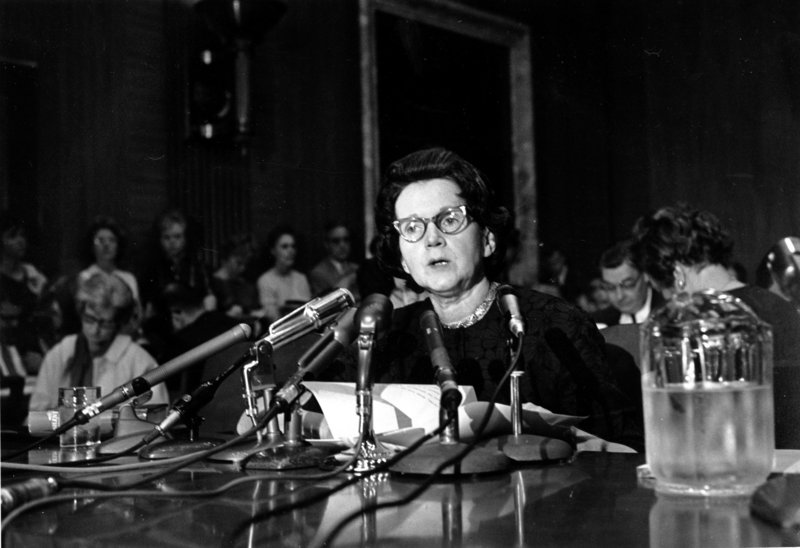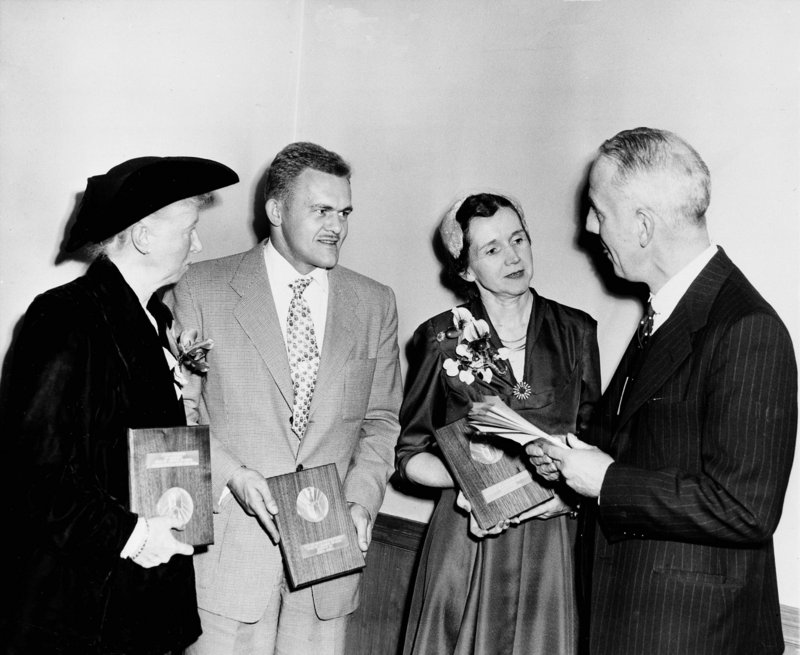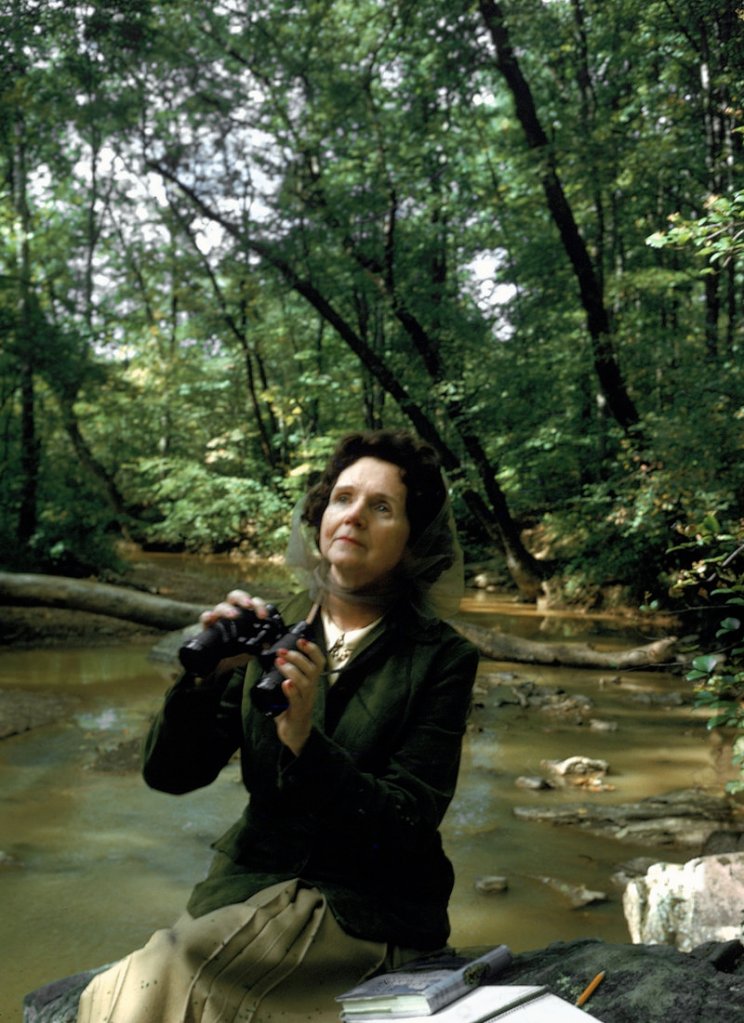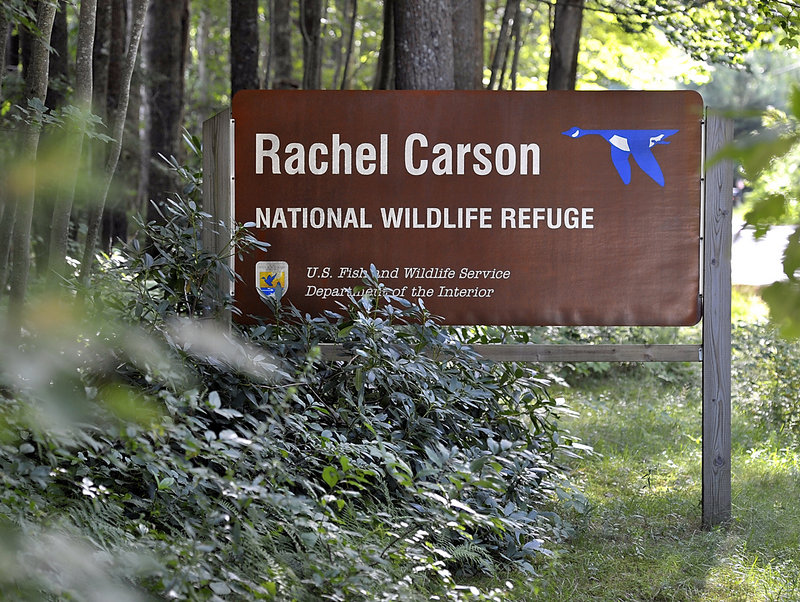First in an occasional series on Rachel Carson a half-century after the publication of “Silent Spring.” On Monday, women inspired by Carson become environmental activists.
Some hailed her as a prophet of the environmental movement; others disparaged her work as alarmist and lacking scientific rigor.
But there is no doubt that Rachel Carson and her writings were virtually a force of nature in the 1950s and ’60s.
And still are today.
Fifty years after the publication of “Silent Spring,” Carson’s groundbreaking book questioning the excessive use of pesticides still evokes strong feelings on all sides. Carson became the grand dame of the modern environmental movement, as “Silent Spring” awakened ordinary Americans to the potential problems from unrestrained pesticide use. The book captured the attention of President John F. Kennedy and was pivotal in the banning of the commonly used pesticide dichlorodiphenyl-trichloroethane, or DDT, in 1972. It led to a grassroots movement questioning the safety of pesticide use and public calls for greater governmental control of the industry.
Even now, both the book and the author herself remain icons of how a single individual can change the course of a nation’s history. And the debate Carson opened with the volley of “Silent Spring” remains highly charged and unresolved, namely, whether — and how — farmers, foresters and ordinary citizens can use chemical pesticides responsibly.
WRITER WITH DEEP TIES TO MAINE
A writer for the U.S. Fish and Wildlife Service, Carson had deep and lasting ties to Maine, where she spent many summers and sought sanctuary on Southport Island at the tip of the Boothbay peninsula, at the mouth of the Sheepscot River. Her experiences and observations from the edge of this quarter-acre salt pond provided much of the research for her popular writings about the sea.
A lifelong conservationist by temperament and teaching, she was living on Southport in 1956 when she became a founding member and the first chairwoman of the Maine chapter of The Nature Conservancy. Her influence is still felt there today through the Rachel Carson Salt Pond Preserve, maintained at the site by the conservancy, and with a continuing endowment sustained by royalties on her books.
Carson was “the most renowned person who ever worked for Fish and Wildlife,” said Ward Feurt, manager of the 5,600-acre wildlife refuge in Wells that was renamed in Carson’s honor in 1970. “Hands down No one else is even close.”
Her name appears on “every single list” naming 20th century women who accomplished “something significant” in environmental, societal, scientific and literary arenas, he added.
Numerous environmental, educational and cultural organizations, from the Fish and Wildlife Service to local colleges and libraries, are hosting events throughout the year in celebration of Carson and her achievements.
Carson was born on May 27, 1907, the youngest of three children. Raised in a rustic farmhouse just outside the Allegheny River town of Springdale, Pa., she had ample opportunity to experience the natural world. She credited her mother with instilling in her the lasting love of nature that flows through her writing like a rising tide.
That passion matured during her years studying biology in college, probing genetics while earning a master’s at Johns Hopkins and through studies at the Marine Biological Laboratory at Woods Hole in Massachusetts, where she first experienced the sea. This turn toward the life sciences was to some degree a change, or at least an interruption of Carson’s plans: Since childhood, she had intended to become a writer — the work she ultimately performed for the U.S. Fish and Wildlife Service, earning $32 a week.
But both endeavors — writing and biological investigation — remained at the center of her life and culminated in the tone of urgency in “Silent Spring.” That fervor had always been there, a current which elevated her books beyond the genre of nature writing and made her a best-selling author whom the public trusted and heeded.
Her commitment to witnessing and protecting the natural world on its own terms was evident even in her early popular writing about the natural history of the sea and shore. It was a commitment with deep personal and spiritual underpinnings, brimming with a sense of protectiveness that one Maine environmental advocate, Nancy Oden of Jonesboro, has described as akin to the “ferocity of a mother bear.”
It was the early lyrical, poetic writings about nature that arguably won her the vast audience that helped sell the message of “Silent Spring,” hardly an easy read in comparison to her previous works. Her authority, expressed largely but not exclusively through her book, endured until her death in April 1964 — two years after her incendiary call to consciousness in “Silent Spring.”
By then, Carson had become one of the most influential — and vilified — women in the world, a fate that a half century later hovers over her name like a migrating bird, drifting off only to return with a new generation.
“She was the first to sound the alarm that we had to think about the environment and what we were doing to it,” said Christine Baumann Feurt, an environmental studies instructor at the University of New England in Biddeford and coordinator of the Coastal Training Program at the Wells National Estuarine Research Reserve. “I don’t think anyone has had the impact she had.”
“She was in a way a reluctant Paul Revere,” said Baumann Feurt. “Silent Spring” was not a book she wanted to write but one she felt compelled to complete.
She had been spurred to write the book by the grief and worry of a friend in Massachusetts whose property inadvertently had been covered by DDT from nearby aerial spraying for mosquitoes. The next day, after the air had cleared, she discovered dead songbirds in her yard. She wrote to Carson at the Fish and Wildlife Service, asking how she could stop further spraying.
In looking for an answer, Carson gathered information she found both unexpected and disturbing: The extent and potency of pesticide use had become widespread, almost ubiquitous. She spent the next four years researching and writing “Silent Spring.”
ATTEMPTS TO DISCREDIT HER WORK
Often characterized as a somewhat shy woman, Carson was anything but reticent when she found her environmentalist voice in “Silent Spring.” She challenged the powerful interests of industry and government, documenting the deadly impact of excessive use of pesticides on the environment — particularly on birds, fish and plant life.
The book was first serialized in The New Yorker magazine, which no doubt helped to launch it into the national limelight. But “for a nonfiction book at that time to become a best-seller” was almost unheard of, said Baumann Feurt. Equally telling about its influence was the fury of reaction from representatives of chemical companies and even government agencies.
“The book’s legacy is mixed,” writes Roger E. Meiners and Andrew P. Morriss, in “Silent Spring at 50: Reflections on an Environmental Classic,” published by the Property and Environment Research Center. The center is an environmental think tank promoting “free-market environmentalism as opposed to government regulation,” based in Bozeman, Mont. “It helped raise awareness about the costs of mass spraying operations, but it also provided justification against the use of DDT in malaria-control programs, which contributed to the deaths of millions in Africa and Asia.”
The authors, both college professors, contend that “Silent Spring” served as an anti-technology tool, disparaging progress and discouraging innovation. ” ‘Silent Spring’ presented an emotional argument against chemical pesticides … Above all, (it) is a work of advocacy, weaving anecdotes and carefully selected bits of science into a compelling brief against uses of chemicals that had already saved millions of lives at the time Carson wrote.”
The attempt, then and now, to discredit her work as “emotional” and unscientific goes to the heart of attacks on Carson as a woman working out of her depth, a writer masquerading as a scientist. That kind of innuendo began surfacing almost before the ink was dry on the published page.
She was dismissed at the time as “a spinster who (didn’t) know what she’s talking about,” said Baumann Feurt. But while “Silent Spring” “wasn’t a peer-reviewed article, it was based on peer-reviewed articles.” The list of her sources alone — gleaned from a wide range of scientific disciplines — runs 55 pages.
By the time the first installments of the book were published, Carson already knew she was dying of breast cancer, said Feurt. But in spite of her deteriorating health, she continued to deliver public lectures on the threats posed by pesticides and even appeared twice before Congress to present the material she had gleaned from years of research and writing.
“It is hard to remember the cultural climate that greeted ‘Silent Spring,’ and to understand the fury that was launched against its quietly determined author,” writes Linda Lear, editor of “Lost Woods: The Discovered Writing of Rachel Carson,” in an introduction to the 2002 reprint of “Silent Spring.” “Carson’s thesis that we were subjecting ourselves to slow poisoning by the misuse of chemical pesticides that polluted the environment may seem like common currency now, but in 1962 ‘Silent Spring’ contained the kernel of social revolution.
“Carson was an outsider who had never been part of the scientific establishment, first because she was a woman but also because her chosen field, biology, was held in low esteem in the nuclear age. Her career path was nontraditional; she had no academic affiliation, no institutional voice.” But “as the science establishment would discover, it was impossible to dismiss her.”
CATALYST FOR A MOVEMENT
From the seeds of “Silent Spring” and other examinations of how human beings were fraying the fabric of their interwoven relationship with the natural world, whole new areas of scientific investigation and analysis have emerged. Ecology and environmental studies programs abound in colleges and universities across the country, and current scientific studies probe issues such as how chemicals might be affecting the genetic inheritance of humans and animals.
In the past half-century, numerous environmental, conservation and agricultural developments have been linked to Carson and the consciousness change she generated with the issues raised in “Silent Spring”:
These include:
• the establishment in 1970 of the U.S. Environmental Protection Agency, which serves as the regulatory body for the chemical and pesticide industry;
• key environmental legislation, including the Environmental Protection Act of 1970, the Clean Air and Clean Water acts, and the Endangered Species Act of 1973;
• a popular and growing modern environmental movement including at least 12,000 grass-roots groups, some 150 major nationwide organizations, a total estimated budget of $600 million a year and the membership or participation of about 14 million Americans;
• significant political voice and clout at all levels of government, from local to national;
• a more rigorous registration and re-registration process for all pesticide products, including more than 120 safety, environmental and health tests to determine possible effects on consumers, wildlife and the environment;
• a greater and increasing emphasis on local food production and organic methods of farming;
• required training of pesticide applicators and the development of more precision application systems;
• increased emphasis on integrated pest management, a multifaceted form of pest control that uses a range of techniques to reduce pesticide use, energy consumption and potential environmental impact, while maintaining quality and quantity of food production.
With such transformations in science and culture, regulatory action and government monitoring, Carson’s legacy still looms large. As for whether her concerns were “hysterical and alarmist” — as her detractors have consistently claimed — or a sobering warning about the impact of human ingenuity, there can be little question whether the past 50 years have vindicated her concerns.
“Yeah, of course,” says Baumann Feurt. “And then some.”
Staff Writer North Cairn can be contacted at 791-6325 or at:
ncairn@mainetoday.com
Correction: This story was revised at 10:35 a.m., Aug. 13, 2012, to state that Southport Island is at the tip of the Boothbay peninsula, at the mouth of the Sheepscot River.
Send questions/comments to the editors.





